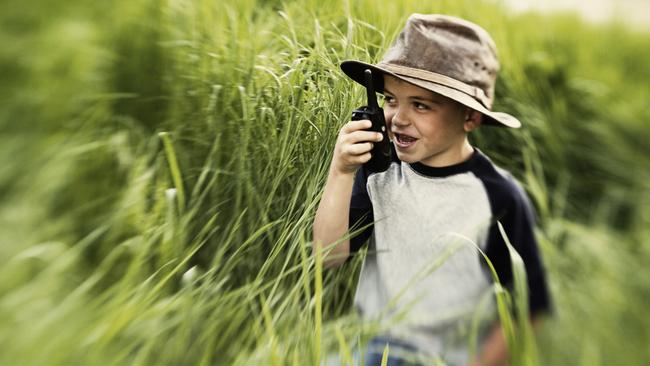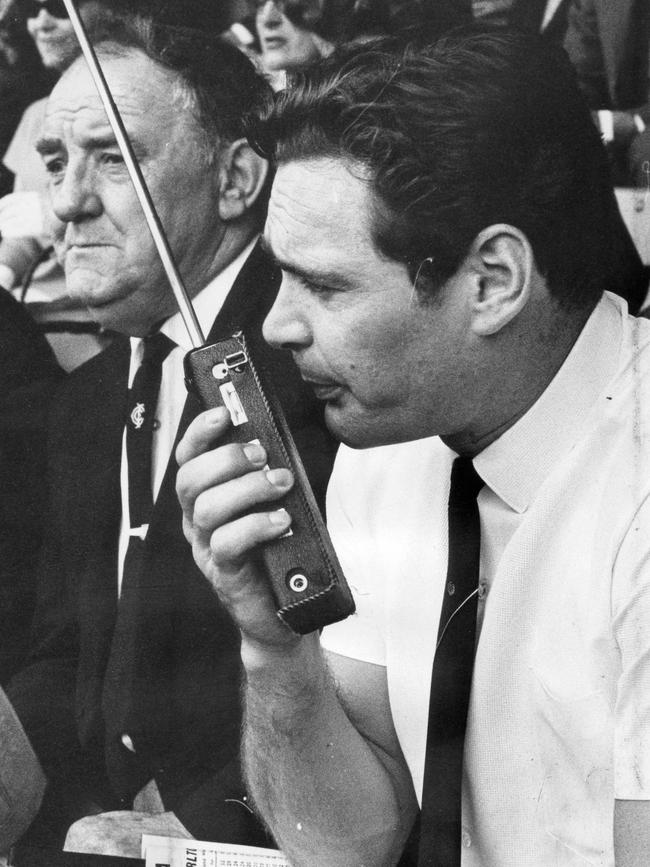Walkie-talkies make a comeback. Roger that? Over and out.
Now that home is an office, school and playground, walkie-talkies are an efficient way to keep tabs on your kids and vice versa.

While attorney Eric Monzo took part in a bankruptcy-court videoconference last month, he kept an eye on his new link to the world outside the guest bedroom of his Delaware home: a Pokemon-themed yellow walkie-talkie.
A family friend gave his six-year-old twins two of the push-to-talk devices last year, for a way to talk to each other from different parts of the house.
Now that the house is also an office, school and playground, thanks to coronavirus stay-home rules, he finds walkie-talkies are also the most efficient way to keep tabs on his children and vice versa. His 9-year-old daughter regularly radios in to ask her dad how he’s doing and to make sure he looks out the window to watch her on the monkey bars.
“Who knew that I would be using it?” said Mr. Monzo, a restructuring and insolvency partner at law firm Morris James LLP. “I am trying to juggle life and work and save businesses and save my family’s health, and we are finding a new way to communicate.” The humble walkie-talkie and other push-to-talk two-way communications, whose consumer use seemed to be going the way of the transistor radio, are getting a new life in the midst of a pandemic.
Children are using them to stay in touch without hogging the Wi-Fi bandwidth parents need for videoconferences. Co-workers are turning to walkie-talkie devices and apps to avoid having to type or dial as they work remotely. Spouses and roommates are using them to stay in touch as they work in different corners of homes.
“Scones in the living room? Over!” one of Lucy Powderly’s housemates said through a walkie-talkie app on their smartphones one afternoon.
“I was just about to ask the same thing! Over!” Ms. Powderly replied. Shared scones and morning pilates are among the few social interactions Ms. Powderly and her housemates can enjoy as they quarantine together in Brighton, England. The University of Sussex student presses the walkie-talkie app throughout the day to instantly say hello to her sisters, whom she hasn’t been able to visit in weeks. “It’s like they’re with you,” she said.
“We’re so desperate for communication and social interaction at a time when we’re all so physically distant from each other,” Ms. Powderly said. Walkie-talkie-style communication is more immediate than calling on the phone, typing out a text message or even initiating a FaceTime video session, she added.
Mobile two-way radios date to the late 1930s but were pretty clunky at first. Shortly before World War II, engineers at Galvin Manufacturing Corp., predecessor to Motorola Solutions Inc., developed a model that a soldier could use with one hand, a boon to battlefield communications. Among other things it helped the forces that landed on the beaches at Normandy stay in contact with each other and with officers aboard ships.

two way radio on the sidelines during
Sturt vs Carlton Champions of Australia
match at Adelaide Oval, 05 Oct. 1968.
Walkie-talkies have had a long life ever since with public-safety officials and work crews in certain businesses such as mining, not to mention Hollywood, in productions such as “Jurassic Park,” “Ghostbusters” and Netflix’s “Stranger Things.” As the coronavirus reshapes how people live and work, the simplicity and immediacy of the push-to-talk feature has gained greater appeal.
Motorola Solutions has seen an increase in demand for walkie-talkies since the beginning of March, a spokeswoman said, driven by consumers, by businesses such as restaurants co-ordinating kerbside pick-ups, and by healthcare organisations with staff that need to quickly communicate.

at a drive-thru testing facility for COVID-19 in Uruguay on April 6.
Photo: AP.
Sophie Hobson and her husband work in separate corners of their two-level London flat and radio each other for lunch and tea breaks using yellow Motorola walkie-talkies, which he once acquired for his fishing trips.
“Are you ready for lunch? Over,” they’ll ask, or one will summon the other by saying, “Come in, come in, are you there? Over.” “It’s quite an overwhelming situation at the moment,” said Ms. Hobson, head of communications at a charity called the School for Social Entrepreneurs. “I think finding a little bit of fun in and among it all is really important for your wellbeing and for your relationship.” Maggie Beasley and a friend from her third-grade class, who lives in a nearby house in Humble, Texas, use a pair of walkie-talkies to communicate now that they can’t play in person. Sitting in a beanbag chair in her front yard in late March, the 9-year-old described the blue slime she had made to her friend across the road.
The Beasley family began distancing themselves from friends several weeks ago because Maggie’s father is a firefighter and a paramedic exposed to sick patients. The decision led to “a lot of tears from the kids,” said Maggie’s mother, Tara, so they have bent some rules to make the change easier.
“Never in my life have I allowed slime, but here we are,” said Ms. Beasley. Maggie made a fort with umbrellas and towels one day when it started to rain so she could stay at her post outside looking at her friend while talking over the walkie-talkie.
In his southwest Arkansas neighbourhood, Nichole Holze’s 8-year-old son has started playing Battleship from his kitchen table with a friend in California using a walkie-talkie-style, push-to-talk radio device called a Relay Go, which uses cell service. Each boy uses one to announce his latest move and exchange jokes while they play.
“It’s nice for a quick check-in and just kind of brightens everyone’s mood a bit,” Ms. Holze said.
Leanee Marsh is at home with three children while teaching seventh-grade science remotely in the suburbs of Charleston, S.C. Her 9-year-old daughter, whom Ms. Marsh deems too young for a cellphone, uses a walkie-talkie-like device to talk to friends, including some the family had planned to see during a cancelled Easter trip to Michigan.
“Being able to talk to people that they were looking forward to seeing — it doesn’t take the place of that but it definitely helps,” she said. “It’s a way to have a conversation with someone other than their mom.”






